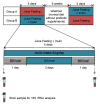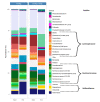Assessment of the Gut Microbiota during Juice Fasting with and without Inulin Supplementation: A Feasibility Study in Healthy Volunteers
- PMID: 36429265
- PMCID: PMC9689797
- DOI: 10.3390/foods11223673
Assessment of the Gut Microbiota during Juice Fasting with and without Inulin Supplementation: A Feasibility Study in Healthy Volunteers
Abstract
Prebiotic inulin consumption provides health benefits to the host and has also been associated with a reduction in hunger cravings. We conducted a pilot crossover study to investigate the feasibility of a juice fasting intervention with and without inulin supplementation. We also examined trends of how the microbial community in the human gut adapts to juice fasting as well as to inulin intake during juice fasting. Six healthy volunteers were fasting for three consecutive days consuming a total of 300 kcal daily provided by vegetable juices, framed by two days with a total daily calorie intake of 800 kcal, respectively. During one fasting period, participants consumed additionally 24 g of inulin daily. Stool samples were collected for the analysis of the microbial composition using 16S rRNA gene sequencing. Although no significant uniform changes were observed on the microbiome, quantitative changes in the microbial composition suggest a stronger decrease in alpha-diversity after fasting compared to the fasting intervention with additional inulin intake. The intake of inulin did not affect compliance for the fasting intervention but appeared to increase relative abundance of Bifidobacteria in participants who tolerated it well. Further studies with a larger sample size to overcome inter-individual microbiota differences are warranted to verify our observations.
Keywords: crossover study; dietary intervention; fasting; feasibility study; human gut microbiome; inulin; juice fasting; pilot study; prebiotics.
Conflict of interest statement
The authors declare no conflict of interest.
Figures




Similar articles
-
Habitual dietary fibre intake influences gut microbiota response to an inulin-type fructan prebiotic: a randomised, double-blind, placebo-controlled, cross-over, human intervention study.Br J Nutr. 2018 Jan;119(2):176-189. doi: 10.1017/S0007114517003440. Epub 2018 Jan 8. Br J Nutr. 2018. PMID: 29307330 Clinical Trial.
-
Prebiotic supplementation over a cold season and during antibiotic treatment specifically modulates the gut microbiota composition of 3-6 year-old children.Benef Microbes. 2019 Apr 19;10(3):253-263. doi: 10.3920/BM2018.0116. Epub 2019 Feb 19. Benef Microbes. 2019. PMID: 30776899 Clinical Trial.
-
The Microbiome and p-Inulin in Hemodialysis: A Feasibility Study.Kidney360. 2021 Jan 15;2(3):445-455. doi: 10.34067/KID.0006132020. eCollection 2021 Mar 25. Kidney360. 2021. PMID: 35369018 Free PMC article.
-
The effects of inulin on gut microbial composition: a systematic review of evidence from human studies.Eur J Clin Microbiol Infect Dis. 2020 Mar;39(3):403-413. doi: 10.1007/s10096-019-03721-w. Epub 2019 Nov 9. Eur J Clin Microbiol Infect Dis. 2020. PMID: 31707507
-
Effect of fructans, prebiotics and fibres on the human gut microbiome assessed by 16S rRNA-based approaches: a review.Benef Microbes. 2020 Mar 27;11(2):101-129. doi: 10.3920/BM2019.0082. Epub 2020 Feb 19. Benef Microbes. 2020. PMID: 32073295 Review.
References
Grants and funding
LinkOut - more resources
Full Text Sources

